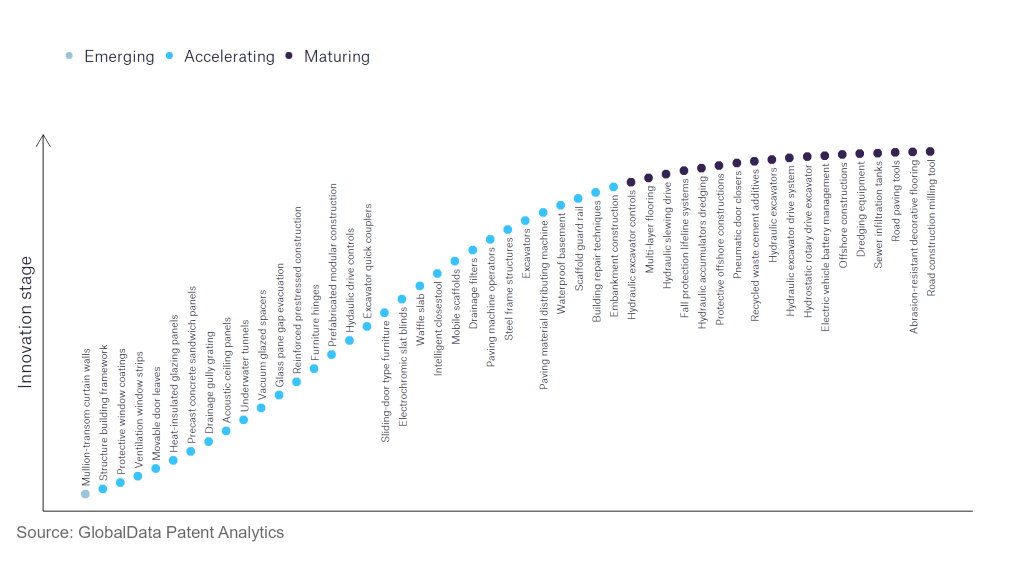The construction industry continues to be a hotbed of innovation, with activity driven by an increased focus on environmental sustainability and workplace safety, and the growing importance of technologies such as the Internet-of-Things (IoT) and robotics as well as higher quality construction products and materials. In the last three years alone, there have been over 248,000 patents filed and granted in the construction industry, according to GlobalData’s report on Innovation in Construction: Heat-insulated glazing panels. Buy the report here.
However, not all innovations are equal and nor do they follow a constant upward trend. Instead, their evolution takes the form of an S-shaped curve that reflects their typical lifecycle from early emergence to accelerating adoption, before finally stabilising and reaching maturity.
Identifying where a particular innovation is on this journey, especially those that are in the emerging and accelerating stages, is essential for understanding their current level of adoption and the likely future trajectory and impact they will have.
80+ innovations will shape the construction industry
According to GlobalData’s Technology Foresights, which plots the S-curve for the construction industry using innovation intensity models built on over 179,000 patents, there are 80+ innovation areas that will shape the future of the industry.
Within the emerging innovation stage, mullion-transom curtain walls is a disruptive technology that is in the early stages of application and should be tracked closely. Heat insulated glazing panels, drainage gully grating, and acoustic ceiling panels are some of the accelerating innovation areas, where adoption has been steadily increasing. Among maturing innovation areas are abrasion-resistant decorative flooring and road construction milling tool, which are now well established in the industry.
Innovation S-curve for the construction industry

Heat-insulated glazing panels are a key innovation area in construction
Heat-insulated glazing panels are used in doorways or window places to reduce the transfer of heat from the inside of the building to the exterior. Panels, usually glass or plastic, are spread so that a layer of air or gas is locked in vacuum between each panel. Panels are usually made up of two to three layers and can be known as double or triple glazing.
GlobalData’s analysis also uncovers the companies at the forefront of each innovation area and assesses the potential reach and impact of their patenting activity across different applications and geographies. According to GlobalData, there are 20+ companies, spanning technology vendors, established construction companies, and up-and-coming start-ups engaged in the development and application of heat-insulated glazing panels.
Key players in heat-insulated glazing panels – a disruptive innovation in the construction industry
‘Application diversity’ measures the number of different applications identified for each relevant patent and broadly splits companies into either ‘niche’ or ‘diversified’ innovators.
‘Geographic reach’ refers to the number of different countries each relevant patent is registered in and reflects the breadth of geographic application intended, ranging from ‘global’ to ‘local’.
Patent volumes related to heat-insulated glazing panels
| Company | Total patents (2021 - 2023) | Premium intelligence on the world's largest companies |
| Panasonic | 586 | Unlock Company Profile |
| KGIC Merger | 501 | Unlock Company Profile |
| AGC | 178 | Unlock Company Profile |
| AGC Glass Europe | 134 | Unlock Company Profile |
| VKR Holding | 124 | Unlock Company Profile |
| Nippon Sheet Glass | 119 | Unlock Company Profile |
| Luoyang Landglass Technology | 116 | Unlock Company Profile |
| Compagnie de Saint-Gobain | 92 | Unlock Company Profile |
| LG | 88 | Unlock Company Profile |
| Cardinal Glass Industries | 70 | Unlock Company Profile |
| Guardian Europe | 44 | Unlock Company Profile |
| Dover | 37 | Unlock Company Profile |
| View | 36 | Unlock Company Profile |
| Eversealed Windows | 36 | Unlock Company Profile |
| Prince International | 29 | Unlock Company Profile |
| Showa Denko | 28 | Unlock Company Profile |
| Infinite Edge Technologies | 20 | Unlock Company Profile |
| Yazaki | 18 | Unlock Company Profile |
| Grenzebach Maschinenbau | 17 | Unlock Company Profile |
| Hitachi | 15 | Unlock Company Profile |
| Research Frontiers | 14 | Unlock Company Profile |
| Technoform Glass Insulation Holding | 13 | Unlock Company Profile |
| BASF | 10 | Unlock Company Profile |
| Saint-Gobain Glass France | 9 | Unlock Company Profile |
| Carl Zeiss Stiftung | 7 | Unlock Company Profile |
| V-glass | 7 | Unlock Company Profile |
| Qingdao Hengda Glass Technology | 6 | Unlock Company Profile |
| Mechem Lab | 6 | Unlock Company Profile |
| Forel | 5 | Unlock Company Profile |
Source: GlobalData Patent Analytics
Panasonic is the leading filer in heat-insulated glazing panel manufacturing. It uses the latest technologies such as Low-E coatings and advanced gas fill systems, which provide insulation and energy efficiency for the heat-insulated panel. One of the company’s inventions intends to keep the vacuum airtight for longer periods of time by reducing the degradation of the spacer and adhesive.
In terms of application diversity, BASF is among the leaders in the pack, along with Hitachi. By means of geographic reach, Research Frontiers holds the top position, followed by Infinite Edge Technologies and Luoyang Landglass Technology.
To further understand the key themes and technologies disrupting the construction industry, access GlobalData’s latest thematic research report on Construction.
Data Insights
From

The gold standard of business intelligence.
Blending expert knowledge with cutting-edge technology, GlobalData’s unrivalled proprietary data will enable you to decode what’s happening in your market. You can make better informed decisions and gain a future-proof advantage over your competitors.



